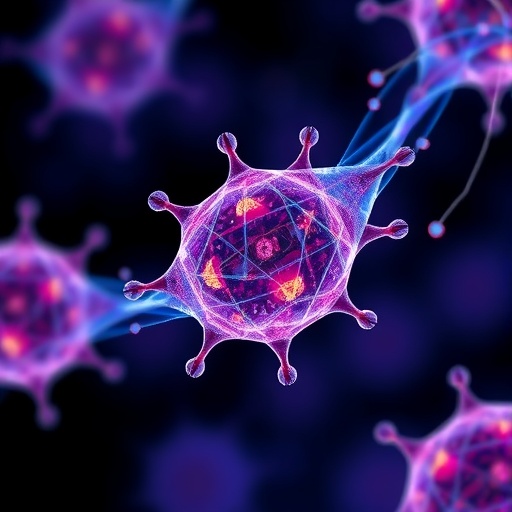In the relentless quest to conquer pancreatic cancer, a team of researchers has unveiled a groundbreaking approach that could redefine therapeutic strategies for this devastating disease. Pancreatic cancer remains one of the deadliest malignancies worldwide, notorious for its aggressive progression, late diagnosis, and resistance to conventional treatments. Now, a novel study published in BMC Cancer highlights an innovative delivery system that marries cutting-edge nanotechnology with molecular targeting to amplify anti-cancer effects and thwart the spread of pancreatic tumors.
At the heart of this breakthrough lies AMTB hydrochloride, a potent inhibitor of the transient receptor potential melastatin 8 (TRPM8) ion channel. TRPM8, typically known for its role in sensing cold stimuli, has recently emerged as an unexpected but critical player in cancer biology, specifically in pancreatic carcinogenesis. Elevated TRPM8 expression in pancreatic tumor tissues correlates with worse patient outcomes, implicating this channel as a potential therapeutic target.
Recognizing the limitations of AMTB’s bioavailability and delivery, the researchers ingeniously encapsulated the compound within chitosan-based nanoparticles, creating a nanoformulation dubbed CS-NPs@AMTB. Chitosan, a naturally derived polysaccharide from crustacean shells, offers a biocompatible, biodegradable platform for controlled drug delivery, enhancing stability and targeting capabilities while minimizing systemic toxicity.
In vitro experiments revealed the profound efficacy of CS-NPs@AMTB across multiple pancreatic cancer cell lines. Notably, this nanoparticle system dramatically inhibited cancer cell proliferation, migration, and invasion—key hallmarks of tumor aggressiveness. The mechanism of action appears rooted in the suppression of the epithelial-mesenchymal transition (EMT) process, a cellular program that endows cancer cells with invasive properties. Additionally, levels of matrix metalloproteinases MMP2 and MMP9, enzymes instrumental for extracellular matrix degradation and metastasis, were significantly reduced upon treatment.
The superior performance of the CS-NPs@AMTB formulation compared to free AMTB extends beyond cellular assays. In animal models, the nanoparticle delivery method achieved approximately 70% reduction in tumor size, marking a profound enhancement in antitumor activity. This striking in vivo efficacy underscores the potential of nanotechnology-driven drug delivery systems to overcome pharmacokinetic barriers that have historically hindered the clinical impact of molecular inhibitors like AMTB.
Biological safety assessments of both free AMTB and the nanoparticle-encapsulated form demonstrated favorable toxicity profiles, addressing a critical concern in cancer therapy development. The targeted delivery via chitosan nanoparticles likely contributes to reduced off-target effects, sparing healthy tissues from cytotoxic insults commonly associated with chemotherapy.
Importantly, this study pioneers the use of chitosan nanoparticle systems specifically for AMTB delivery in pancreatic cancer, bridging a critical gap between molecular understanding and practical translational applications. The convergence of TRPM8 inhibition with advanced nanocarrier technology presents a two-pronged strategy to not only arrest tumor growth but also inhibit the metastatic cascade, which is the principal cause of mortality in pancreatic cancer patients.
The authors emphasize the necessity of further research, advocating for thorough preclinical validation and eventual clinical trials to affirm safety, dosage parameters, and therapeutic efficacy in humans. Given the recalcitrant nature of pancreatic tumors and the dearth of effective treatments, this nanoparticle-based approach holds promise to be integrated into customized therapeutic regimens that could personalize and improve patient outcomes.
Beyond pancreatic cancer, the implications of this research ripple into broader oncology domains. By leveraging the unique properties of chitosan nanoparticles to enhance delivery and bioactivity of molecular inhibitors, this platform could be adapted for other malignancies where TRPM8 or similar pathways play pivotal roles. The versatility and modularity of the nanoparticle system envisage a new horizon for precision oncology.
Additionally, this innovative strategy challenges the traditional paradigms of drug administration. Controlled release kinetics, enhanced cellular uptake, and targeted interaction harnessed by the CS-NPs@AMTB design provide a framework to optimize pharmacodynamics and reduce systemic toxicity. These characteristics are pivotal in elevating patient quality of life during treatment.
The translational potential of this research underscores the importance of multidisciplinary collaboration, marrying materials science with molecular oncology to tackle complex clinical challenges. As nanomedicine continues to evolve, tailored interventions like CS-NPs@AMTB may soon shift from experimental therapy to standard clinical practice, symbolizing a new dawn in cancer treatment.
While the promise is immense, hurdles remain. Large-scale production, regulatory approvals, long-term safety studies, and the intricacies of human tumor microenvironments demand exhaustive investigation. Nevertheless, the compelling preclinical data from this study ignite optimism for a future where “undruggable” tumors might be rendered vulnerable through smart delivery vehicles and precision molecular inhibition.
In sum, the enhancement of AMTB hydrochloride’s therapeutic efficacy via chitosan nanoparticle encapsulation embodies a significant advance in pancreatic cancer research. Through this sophisticated drug delivery approach, the study not only offers a potent weapon against a notoriously fatal disease but also exemplifies the potential of nanotechnology to reinvent cancer therapy paradigms. As this research journey progresses, hope intensifies for patients battling pancreatic cancer and for the oncology community striving toward curative breakthroughs.
Subject of Research: Pancreatic cancer; nanoparticle drug delivery; TRPM8 ion channel inhibition; chitosan nanoparticles; cancer therapeutics.
Article Title: Enhanced anti-cancer effect of AMTB hydrochloride via chitosan nanoparticles in pancreatic cancer.
Article References:
Liu, J., Gong, Y., Zeng, X. et al. Enhanced anti-cancer effect of AMTB hydrochloride via chitosan nanoparticles in pancreatic cancer. BMC Cancer 25, 944 (2025). https://doi.org/10.1186/s12885-025-14356-w
Image Credits: Scienmag.com




